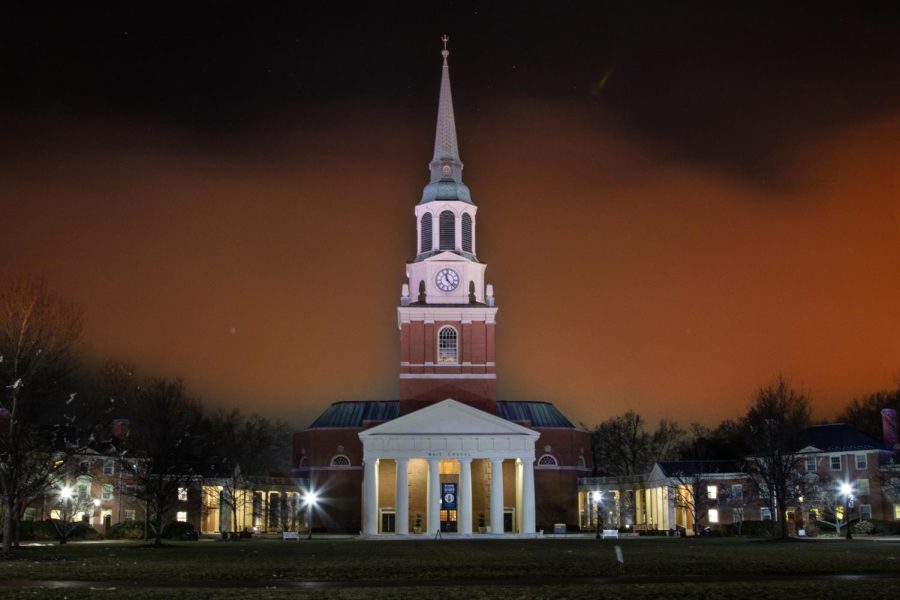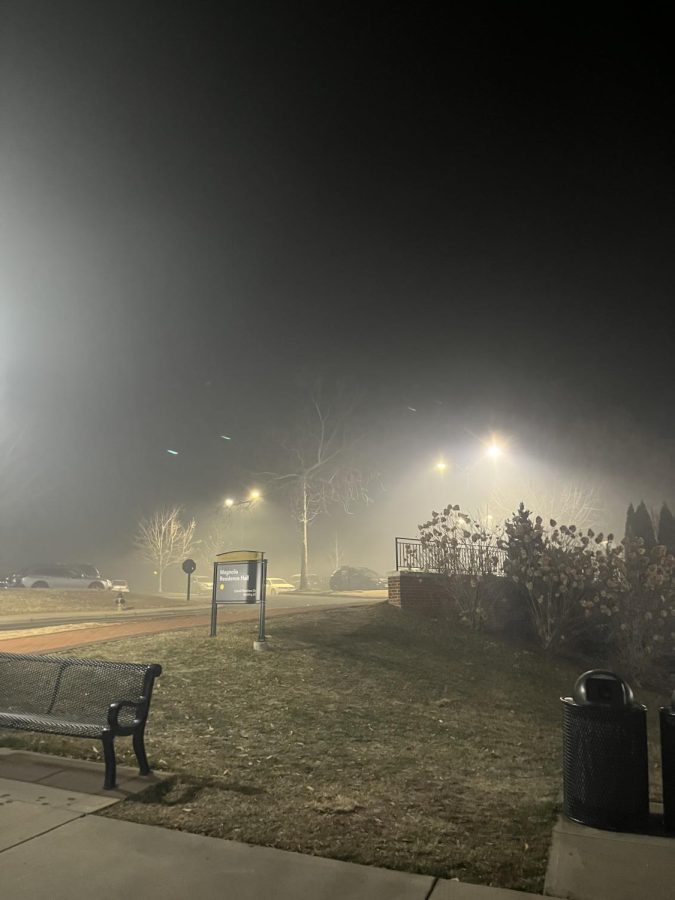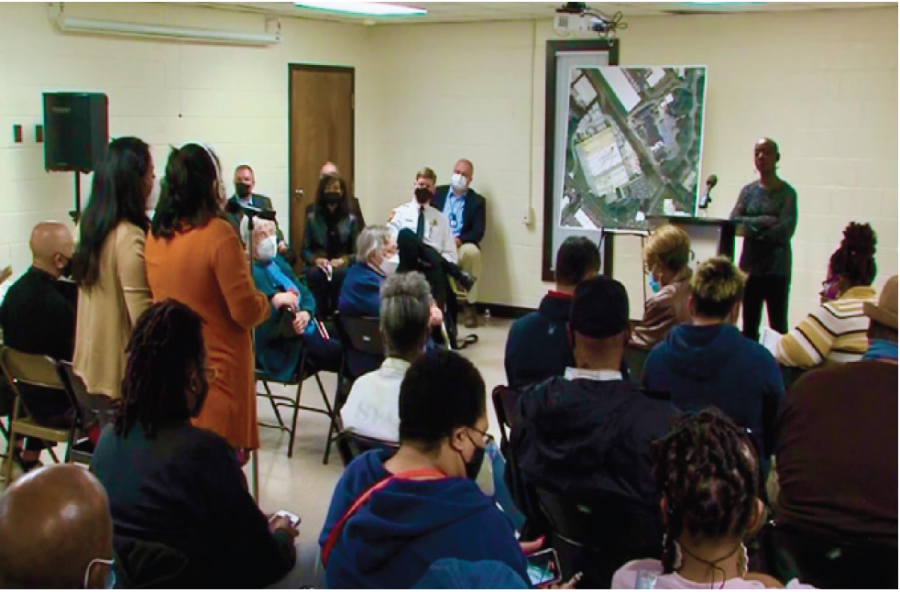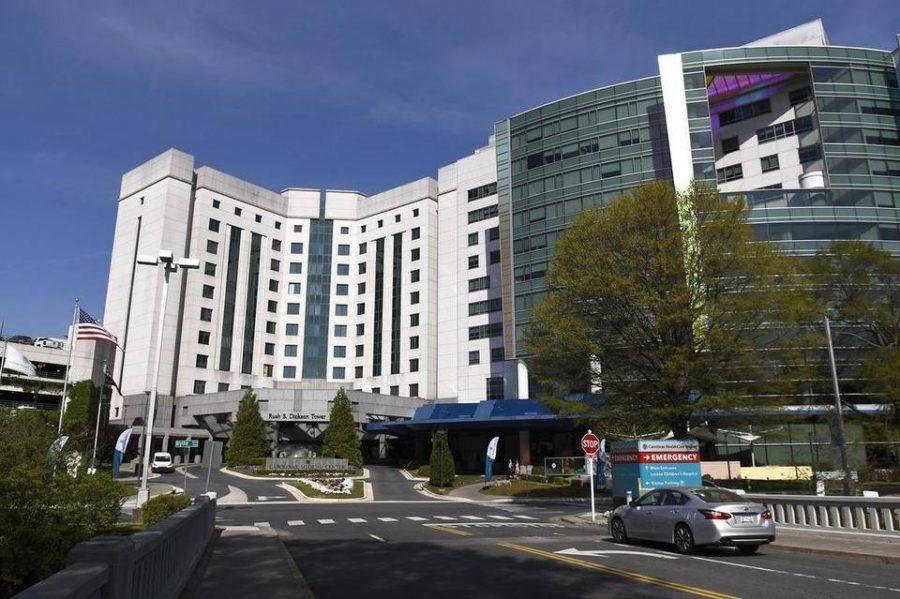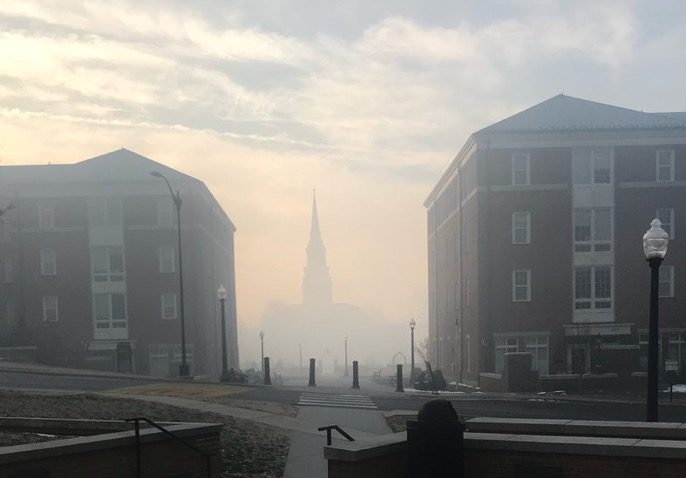A haze of smoke from the Weaver Fire covers the quad.
Looking back, moving forward: One year after the Weaver Fire
While the threat of an explosion has long since passed, its impacts on Winston-Salem and Wake Forest are still felt
February 1, 2023
Just over a year ago, on the evening of Jan. 31, 2022, Wake Forest students on and around North Campus were met with the sight of a yellow-brown chemical haze. As the plume of smoke moved southward and infiltrated campus, reports that the smoke was from an ammonium nitrate-fueled fire at the Winston Weaver Co., a fertilizer plant on North Cherry Street, reached students by Wake Alert .
In the following days, the fear of an explosion affected thousands and made the Weaver Fertilizer Plant fire one of the most notorious on-campus events in recent memory. The fire forced 6,000 Winston-Salem residents, including about 1,000 Wake Forest students and faculty, to evacuate from the one-mile radius surrounding the plant.
In the year since the fire, the event has cemented itself in both Winston-Salem’s and Wake Forest’s history. While the cause of the fire remains undetermined, it has had some obvious effects on the community. In response to the fire, Wake Forest University has pledged a renewed commitment to environmental justice efforts in Winston-Salem.
Additionally, the city of Winston-Salem approved $1 million in relief funds for residents financially impacted by the fire, and Atrium Health Wake Forest Baptist recently announced that it will conduct a study on the long-term health effects of the blaze.
Update 8:10 p.m., Feb. 1, 2023: The “Winston-Salem’s Response” section of this story has been updated to reflect new information received from Experiment in Self Reliance, Inc.
The Weaver Fire and Wake Forest
At Wake Forest, the Weaver Fertilizer Plant fire opened the eyes of students and administrators to the realities many Winston-Salem residents have long understood about environmental racism and the necessity for environmental justice initiatives in Winston-Salem, according to Dr. Corey D. B. Walker, the Wake Forest professor of the humanities, founding director of the African American Studies program and interim dean of the School of Divinity. That increased awareness culminated in a $1 million grant from the Mellon Foundation for environmental justice efforts, which the university announced on Jan. 19.
Walker was the visionary behind the Mellon Grant. He, along with Director of the Environment Program Dr. Julie Velásquez Runk, is spearheading environmental justice initiatives at Wake Forest.
“What the Weaver fire did was allow us to be very exposed and very sensitive to the precariousness of individual lives in our society,” Walker said. “…in a broader society, we do have to be concerned about the lives and life chances of those who live a much more precarious existence [than ourselves].”
Walker explained that the goal of the Mellon grant is not for the university to serve the community directly but instead for the university to foster a more humane educational system.
“One reason why I wrote the Mellon grant is to begin to look very systemically at how we begin to educate students and scholars for a new generation while recognizing that the deep inequalities that we have and witness are not just by happenstance,” Walker said. “In many ways, the Weaver fire was not just a disaster that erupted out of nowhere, it was a disaster by design.”
When Walker says “disaster by design,” he is referring to Winston-Salem’s history of redlining and zoning along racial and economic lines, as well as the impacts of agribusiness on the fertilizer industry. Each of these factors are real-world examples that point to the necessity of pursuing environmental justice, which the Environmental Protection Agency (EPA) defines as “the fair treatment and meaningful involvement of all people regardless of race, color, national origin or income, with respect to the development, implementation and enforcement of environmental laws, regulations and policies.”
Moving forward, Wake Forest hopes to develop an environmental justice-focused curriculum within the Environment Program. Velásquez Runk was hired in August 2022 specifically to address this goal.
Velásquez Runk says her vision for the Environment Program as a new hire is to be community and justice-oriented, which is based on her belief that the environment and people are inseparable.
Velásquez Runk’s most recent change to the environment curriculum was introducing “The Intersectional Environmentalist” by Leah Thomas — a book that focuses on the linking systems of the environment, racism and privilege — as a required textbook for ENV 201: Introduction to Environmental Issues.
“In the past, people have been separate from the [study of the] environment…” Velásquez Runk said. “I emphasize this to say that’s not the approach we want in the 21st century.”
Dr. Dean Franco is a professor of literature and director of the Humanities Institute at Wake Forest. He specializes in race studies and human rights and is the author of “The Border and the Line: Race, Literature, and Los Angeles,” which examines neighborhood segregation in Los Angeles, Calif.
Franco says that the definition of a neighbor is someone who is near, meaning that how we treat others often correlates to our awareness and proximity to them.
“When we’re near each other, we feel an obligation toward one another,” Franco said.
Franco says that environmental disasters, like the Weaver Fertilizer Plant fire, offered a wake-up call for many neighbors.
“The environment and environmental disasters have a way of showing where the borderlines of segregation are, because you’re like, ‘Oh, I’ve never seen that neighborhood before, but it’s right near me’” Franco said. “You see where those borderlines are, but the environmental disaster breaches those borderlines really quickly.”
He continued: “[Wake Forest has] been political neighbors to the neighborhoods around us for so long. We have gates and fences and ID cards…when you have an environmental disaster, you become an ethical neighbor. That’s when you realize we are all commonly exposed. We’re all similarly near this thing that’s happening. That’s why [the Weaver Fertilizer Plant fire] was a wake-up call.”
Winston-Salem residents voice their concerns at a City Hall meeting regarding health, financial, and environmental issues in the aftermath of the Weaver fire. According to the Winston-Salem Journal, 81%-85% of residents near the blaze were people of color.
Winston-Salem’s response
In 2022, the city of Winston-Salem set up a $1 million, “first-come-first-serve” fund for those impacted by the fire in response to the fire and evacuations. The city partnered with the Experiment in Self Reliance, Inc. (ESR), a non-profit organization that “serves the low-moderate income population of Winston-Salem/Forsyth County,” to disperse the funds.
The reimbursement fund aimed to cover lost wages, meals, hotel funds and other verifiable expenses only from Jan. 31 to Feb. 4. Those filing for reimbursement were given until June 30 to provide documentation of expenses and request an appointment via ESR.
Victoria von Dohlen, the development and agency relations manager at ESR stated in an email that 800 people applied for assistance and that there are no outstanding applicants. Von Dohlen further said that ESR delegated 656 subsidies, with the households’ median income being $12,784.32. The total amount paid, according to a Sept. 17 Winston-Salem Journal report, was $241,126.12.
As of publication, Councilmember Denise D. Adams did not respond to the Old Gold & Black’s request for an interview about the remaining funds.
One reason for the lack of applications, Walker suggests, is likely the requirement of receipts to demonstrate eligibility. Those who stayed with friends or family members likely didn’t incur direct costs that could be demonstrated through receipts. Thus, their eligibility to receive funds is limited, despite being directly inconvenienced by the fire.
“If I went to stay with my grandmother or a family member in High Point, but I can’t produce a receipt, I still have added costs,” Walker said.
In December 2022, the Winston-Salem City Council passed a new zoning ordinance that adds “use specific standards” for fertilizer, chemical, pesticide and explosive manufacturing. According to the city council minutes, the ordinance (Issue 22-0656) issues specific standards for the placement of these facilities. This includes prohibiting the sites from being “located within a public surface water supply watershed as designated by the North Carolina Department of Environmental Quality (DEQ) and the Public Health Department.” Other requirements include that manufacturing plans have a minimum size of 25 acres and that all facilities must be located a minimum of 400 feet from any exterior property line.
After the fire, Winston Weaver Fertilizer Co. began the process of multi-stage clean up and investigatory procedure. Winston Weaver Fertilizer Co. contracted Montrose Environmental, an environmental services and testing company, to begin an environmental assessment of the Winston Weaver Co. site in May 2022. Its full testing plan was then approved by N.C. Department of Environmental Control’s Inactive Hazardous Sites Branch later in July. The 71-page document shows the company’s aims to evaluate and test soil samples for potential ground and water run-off contamination. The assessment mentions installing five groundwater-monitoring wells and collecting samples across the property to evaluate levels of volatile organic compounds, ammonia, nitrate, phosphates and metals. The details of the full assessment
Atrium Health is conducting a study on the fire’s impact.
Atrium Health Study
Atrium Health Wake Forest Baptist announced last month that it would launch a study on the health and environmental effects of the fire. The study is headed by Dr. Callie Brown, a Wake Forest Medical School alumna.
The study has three components: one in conjunction with the Wake Forest School of Engineering that monitors water, air and soil quality within two miles of the plant; another that examines long-term health effects of the fire on residents, and a third that consists of interviews with 40 residents that lived within a two-mile radius of Winston Weaver Co. at the time of the fire.
“[We] heard from many community members that there was a desire for the fire not to be forgotten about or swept under the rug,” Brown said in regard to her and her colleagues’ motivation behind conducting the study.
Brown emphasized the importance of conducting studies following environmental disasters, particularly in areas that are “systematically disadvantaged,” stating that it is imperative that research like this be done in order to preserve the memory of these events and protect the health of communities.
Given the various aspects of the study, the timeline for results varies. Results on water, air and soil testing, as well as the interviews are expected within the next year. The portion of the study that focuses on long-term health effects will follow those patients for five years to study differences in chronic health diseases, such as asthma, lung disease, heart disease and cancer, according to Brown.
Interviews with Spanish speakers have already concluded, but English speakers living within a two-mile radius of Winston Weaver Co. who are interested in participating in the interview portion of the study are encouraged to contact the study’s community partner, Neighbors for Better Neighborhoods, by calling (336)-602-2475.
Further information regarding the study and its various aspects will be presented at a community meeting on Wednesday, Feb. 1, 2023, from 6-8 p.m. at the Hanes Hosiery Community Center.
Smoke covers the view of Wait Chapel from Polo Residence Hall in Feb. 2, 2022.
Moving Forward
Today, where the fertilizer plant once stood, there is an empty plot of land. The yellow gates are wide open, but it bears a sign saying “Absolutely No Visitors Beyond This Point.” According to a December 2022 article in the Winston-Salem Journal, Winston Weaver Co. has yet to disclose whether or not they plan to rebuild the Cherry Street plant.
The threat of an explosion has long since disappeared, but its impact reverberates throughout the larger Winston-Salem community and at Wake Forest. Time will only tell how the fire is remembered in history, but for now, there remains work to be done to address the issues the blaze both caused and exposed.
